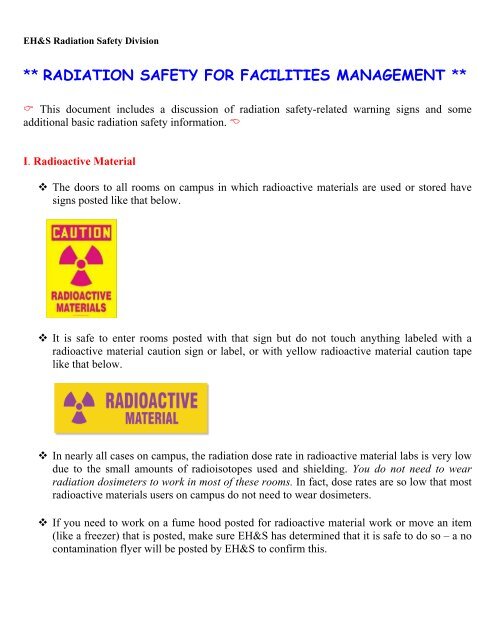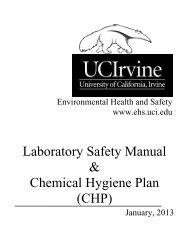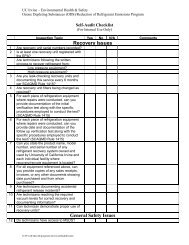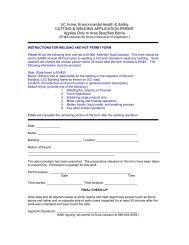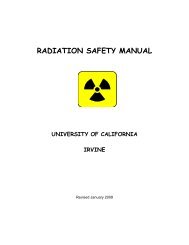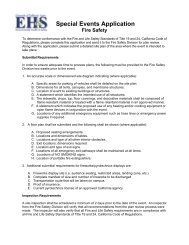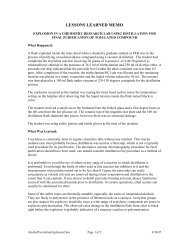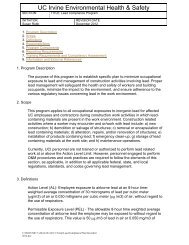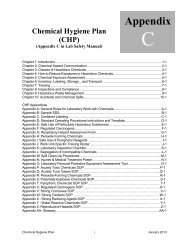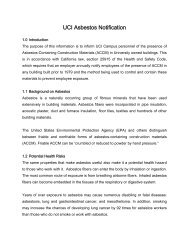RADIATION SAFETY FOR FACILITIES MANAGEMENT
RADIATION SAFETY FOR FACILITIES MANAGEMENT
RADIATION SAFETY FOR FACILITIES MANAGEMENT
You also want an ePaper? Increase the reach of your titles
YUMPU automatically turns print PDFs into web optimized ePapers that Google loves.
EH&S Radiation Safety Division<br />
** <strong>RADIATION</strong> <strong>SAFETY</strong> <strong>FOR</strong> <strong>FACILITIES</strong> <strong>MANAGEMENT</strong> **<br />
This document includes a discussion of radiation safety-related warning signs and some<br />
additional basic radiation safety information. <br />
I. Radioactive Material<br />
The doors to all rooms on campus in which radioactive materials are used or stored have<br />
signs posted like that below.<br />
It is safe to enter rooms posted with that sign but do not touch anything labeled with a<br />
radioactive material caution sign or label, or with yellow radioactive material caution tape<br />
like that below.<br />
In nearly all cases on campus, the radiation dose rate in radioactive material labs is very low<br />
due to the small amounts of radioisotopes used and shielding. You do not need to wear<br />
radiation dosimeters to work in most of these rooms. In fact, dose rates are so low that most<br />
radioactive materials users on campus do not need to wear dosimeters.<br />
If you need to work on a fume hood posted for radioactive material work or move an item<br />
(like a freezer) that is posted, make sure EH&S has determined that it is safe to do so – a no<br />
contamination flyer will be posted by EH&S to confirm this.
II. X-ray Machines<br />
The doors to all rooms containing x-ray machines are posted with signs like that below.<br />
Although the radiation dose rate is generally very low around x-ray machines even when<br />
they are operating, it would be best to make sure that the machines are off before<br />
entering x-ray rooms. Contact lab personnel to determine this.<br />
III. Laser Labs<br />
The doors to all rooms in which hazardous lasers are operated are posted with signs like<br />
those below.<br />
Personnel who work in laser labs are instructed to never leave a laser operating and<br />
unattended. However, occasionally it does happen.<br />
Always ask lab personnel to turn off lasers before you enter a laser lab. If nobody is<br />
present to ask about this, then do not enter the lab.<br />
If a temporary laser warning sign like those below is hanging from the doorknob to the<br />
laser lab, it definitely implies hazardous conditions inside for persons not wearing eye<br />
protection. Other versions of this sign say “Laser Alignment – Do Not Enter” and<br />
“Laser In Use – Do Not Enter”. Never enter a laser lab with one of these doorknob<br />
signs posted!
If you have any doubts about safety in a laser lab, do not enter and contact EH&S (Rick<br />
Mannix; x4-6098).<br />
IV. Ultraviolet Radiation<br />
Several rooms on campus have overhead ultraviolet lights to irradiate and disinfect lab<br />
spaces after studies are performed using biohazardous agents. These rooms should always<br />
be posted with signs similar to those below. The ultraviolet bulbs generally emit a<br />
characteristic blue or purple light that looks a lot different from the normal white light<br />
emitted by standard light bulbs.<br />
Always ask lab personnel to make sure the areas you need to work in are safe regarding<br />
both biohazards and ultraviolet radiation.<br />
Some lab equipment (solar simulators, transilluminators, etc.) and hoods also have<br />
ultraviolet bulbs inside of them. Always ask lab personnel for assistance to make sure it is<br />
safe to work on these items. The equipment will often have a sign like that below posted on<br />
it.
V. High Magnetic Fields<br />
Areas containing high magnetic fields are posted with signs similar to those below. This<br />
includes several Magnetic Resonance Imaging (MRI) facilities and a few Nuclear Magnetic<br />
Resonance (NMR) facilities on campus.<br />
The magnetic fields inside these areas are strong enough to affect heart pacemakers, pull<br />
metal tools and other metal objects out of your hands, erase credit cards, etc.<br />
Never enter a high magnetic field area without permission and an escort by persons who<br />
work in the facilities and are knowledgeable about the hazards.<br />
VI. Microwave Antennas/Cell Phone Sites<br />
All areas with high radiofrequency (RF) radiation or microwave radiation (like cell phone<br />
site antennas) are posted with signs like those below.<br />
There are several cell phone site antennas on campus. It is safe to work around those<br />
antennas as long as you are not directly in front of them and within 10 feet. Off to the side is<br />
okay.
One cell phone site antenna on the roof of Engineering Tower has been turned off since it<br />
was directed at UCI ventilation equipment (blowers).<br />
Cell phone service providers (Sprint, AT&T, etc.) will power down antennas if UCI<br />
personnel must enter areas with elevated RF or microwave radiation.<br />
℡ Contact the Radiation Safety Division of EH&S with any questions or concerns about<br />
radiation safety! We are always willing to help you.


